|
|
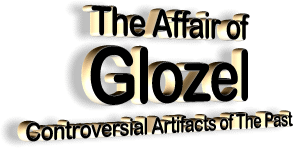
by Philip Coppens |
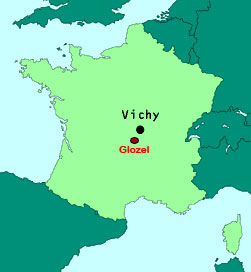 |
Contents
|
Archaeological Trench Warfare at
Glozel
2007
Extracted from Nexus Magazine
Volume 14, Number 5 (August -
September 2007)
from
NexusMagazine Website
|
When artifacts unearthed
at Glozel, France, in the mid-1920s didn't fit the
accepted scholarly explanation of human prehistory
in that region, archaeologists engaged in a bitter
battle that has still not seen a clear winner.
.
About the Author
Philip Coppens is the editor-in-chief of
Conspiracy Times (http://www.conspiracy-times.com).
He has previously contributed eight articles to NEXUS,
the most recent being "State-Sponsored Terror in the
Western World" (see 14/02). Philip is a scheduled
speaker for the forthcoming NEXUS Conference on the
Sunshine Coast, Queensland, Australia, on 20-21-22
October.
Philip's website is
http://www.philipcoppens.com,
and he can be contacted by email at
info@philipcoppens.com.
|
The excavations near the French village of Glozel, a hamlet located
17 kilometers from the French spa town of Vichy, are among the most
controversial of archaeological endeavors. These excavations lasted
between 1924 and 1938, but the vast majority of finds-more than
3,000 artifacts - were unearthed in the first two years. The
artifacts were variously dated to Neolithic, Iron Age and Mediaeval
times.
What transpired is a textbook case of archaeological feuding
and fraud versus truth.
Glozel 101 -
How to get ahead in archaeology
If one word could be used to describe the Glozel affair, it should
be "controversial". It has been described as the "Dreyfus affair" of
French archaeology, and the Dreyfus equivalent was Emile Fradin, a
seventeen-year-old, who together with his grandfather Claude Fradin
stepped into history on 1 March 1924.
Working in a field known as Duranthon, Emile was holding the handles
of a plough when one of the cows pulling it stuck a foot in a
cavity. Freeing the cow, the Fradins uncovered a cavity containing
human bones and ceramic fragments. So far, this could have been just
any usual archaeological discovery, of which some are made every
week. That soon changed.
It is said that the first to arrive the following day were the
neighbors. They not only found but also took some of the objects.
That same month, Adrienne Picandet, a local teacher, visited the
Fradins' farm and decided to inform the minister of education. On 9
July, Benoit Clement, another teacher, this time from the
neighboring village and representing La Societe d'Emulation du
Bourbonnais, visited the site and later returned with a man called Viple.
Clement and Viple used pickaxes to break
down the remaining walls, which they took away with them. Some weeks
later, Emile Fradin received a letter from Viple, identifying the
site as Gallo-Roman. He added that he felt it to be of little
interest. His advice was to recommence cultivation of the
field-which is what the Fradin family did. And this might perhaps
have been the end of the saga, but not so.
The January 1925 Bulletin de la Societe d'Emulation du
Bourbonnais reported on the findings. It brought the story to
the attention of Antonin Morlet, a Vichy physician and amateur
archaeologist. Morlet visited Clement and was intrigued by the
findings. Morlet was an "amateur specialist" in the Gallo-Roman
period (first to fourth centuries AD) and believed that the objects
from Glozel were older.
He thought that some might even date
from the Magdalenian period (12,000-9500 BC). Both Morlet and
Clément visited the farm and the field on 26 April 1925, and Morlet
offered the Fradins 200 francs per year to be allowed to complete
the excavation. Morlet began his excavations on 24 May, discovering
tablets, idols, bone and flint tools, and engraved stones. He
identified the site as Neolithic and published his "Nouvelle Station Néolithique" in September 1925, listing Emile Fradin as co-author.
He argued that the site was, as the title of the article states,
Neolithic in nature.
Though Morlet dated it as Neolithic, he was not blind to see that
the site contained objects from various epochs. He still upheld his
belief that some artifacts appeared to be older, belonging to the
Magdalenian period, but added that the techniques that had been used
appeared to be Neolithic. As such, he identified Glozel as a
transition site between both eras, even though it was known that the
two eras were separated by several millennia.
Certain objects were indeed
anachronistic: one stone showed a reindeer, accompanied by letters
that appeared to be an alphabet. The reindeer vanished from that
region around 10,000 BC, yet the earliest known form of writing was
established around 3300 BC, and that was in the Middle East. The
general consensus was that, locally, one would have to wait a
further three millennia before the introduction of writing. Worse,
the script appeared to be comparable with the Phoenician alphabet,
dated to c. 1000 BC, or to the Iberian script, which was derived
from it. But, of course, it was "known" that no Phoenician colony
could have been located in Glozel.
From a site that seemed to have little or no importance, Glozel
had
become a site that could upset the world of archaeology.
Incontestable
evidence-or not?
No wonder that French archaeological academics were dismissive of Dr
Morlet's report-after all, it was published by an amateur (a medical
doctor) and a peasant boy (who perhaps could not even write
properly). In their opinion, the amateurism dripped off their
conclusion, for it challenged their carefully established and
vociferously defended dogma on several levels. Prehistoric writing?
A crossover between a Palaeolithic and a Neolithic civilization?
Nonsense! And hence, the criticism continued.
One person claimed that the artifacts had to be fakes, as some of
the tablets were discovered at a depth of 10 centimeters. Indeed, if
that were the case they would indeed be fakes, but the problem is
that all the tablets were found at substantial depths-clear evidence
of manipulation of the facts when the facts don't fit the dogma. It
should be noted that the "10 centimeter" argument continues to be
used by several skeptics, who falsely continue to assume it is true.
Unfortunately for French academic
circles, Morlet was not one to lie down easily, and today his ghost
continues to hang-if not watch-over Glozel.
Morlet invited a number of archaeologists to visit the site during
1926; they included Salomon Reinach, curator of the Musée
d'Archéologie Nationale de Saint-Germain-en-Laye, who spent
three days excavating. Reinach confirmed the authenticity of the
site in a communication to the Académie des Inscriptions et
Belles-Lettres. Even higher academic circles descended on the
site: the famous archaeologist Abbé Breuil excavated with Morlet and
was impressed with the site. In late 1926, he wrote two articles, in
which Breuil stated that the authenticity of the Glozel site was
"incontestable".
It seemed too good to be true, and it was.
Breuil worked together with prehistorian André Vayson de Pradenne,
who had visited the site under an assumed name and attempted to buy
the artifacts from Fradin. When Fradin refused, Vayson became angry
and threatened to destroy the site. Under his own name, he obtained
permission to excavate from Dr Morlet, but then claimed to have
detected Fradin spreading salt in the excavation trench. Was Vayson
de Pradenne keeping his promise? Again Morlet chose to attack, and
he challenged Vayson to duplicate what Fradin had allegedly done.
When he was unable to do so, or find where Fradin had supposedly
salted the trench, Morlet felt he had successfully dealt with that
imposter. He was wrong: Vayson de Pradenne's allegation made it into
print.
But it would be a reindeer that soured the relationship between
Breuil and Morlet, as Breuil had identified an engraved animal on a
tablet as a cervid, neither reindeer nor elk.
Morlet had received confirmation from Professor August Brinkmann,
director of the Zoology Department at Bergen Museum, Norway, and
informed Breuil of his mistake. It was the moment when Breuil
changed his attitude. Morlet had begun to make powerful enemies.
More
controversy over site excavations
Rather than talk, Morlet dug, unearthing 3,000 objects over a period
of two years, all of varied forms and shape, including 100 tablets
carrying signs and approximately 15 tablets carrying the imprints of
human hands. Other discoveries included two tombs, sexual idols,
polished stones, dressed stones, ceramics, glass, bones, etc.
Surely, these could not be fakes?
On 2 August 1927, Breuil reiterated that he wanted to stay away from
the site. On 2 October, he wrote that "everything is false except
the stoneware pottery".
Just before that, at the meeting of the International Institute of
Anthropology in Amsterdam held in September 1927, the Glozel site
was the subject of heated controversy. A commission was appointed to
conduct further investigation. Its membership was largely comprised
of people who had already decided the Glozel finds were fraudulent.
Among the group was Dorothy Garrod, who had studied with Breuil.
The commissioners arrived at Glozel on 5 November 1927. During their
excavations, several members found artifacts. But on the third day,
Morlet saw commission members Dorothy Garrod, Abbé Favret and Mr
Hamil-Nandrin slip under the barbed wire and set off towards the
open trench before he had opened the gate. Morlet followed her and
saw that she had stuck one of her fingers into the plaster pattern
on the side of the trench, making a hole. He shouted out,
reprimanding her for what she had just done. Caught in the act, she
at first denied it, but in the presence of her two colleagues as
well as the attorney, Mallat, and a scientific journalist,
Tricot-Royer, she had to admit that she had made the hole.
Though it was agreed they would not speak about the incident
(underlining the fact that some people have more privileges than
others), Morlet did speak about it after the commission had
published its unfavorable report. This might be seen as mudslinging,
trying to get back at the commission, but, unfortunately for those
willing to adhere to this theory, a photograph attested to the
incident. In it, Garrod is hiding behind the four men, who are in
heated discussion about what she had just done. Most importantly,
Tricot-Royer and Mallat also gave written testimony confirming
Morlet's account.
What was Garrod trying to do?
Some have claimed it was merely an
accident, but it is remarkable that she was part of a posse that
entered the site before the "official start" of the day and had an
accident that could have been interpreted as interfering with the
excavation. If others had found that the excavation had been
tampered with, fingers would not have been pointed at Garrod but,
instead, at Fradin - whom the archaeologists suspected of being the
forger, burying artifacts in the ground only to have amateur
archaeologists like Morlet, who did not know "better", discover
them. If this suggestion that Fradin had entered the site at night
had been made, it would have resulted in a "case closed" and the
Glozel artifacts would have been qualified as fraudulent.
The incident did not cause any harm to Dorothy Garrod, who then went
on to teach a generation of British archaeologists at Cambridge.
Perhaps unremarkably, she made sure to tell all of them that the
Glozel artifacts were fakes. And several of her students echoed her
"informed opinion"; the list included Glyn Daniel and
Colin Renfrew,
both fervent critics of the Glozel finds. We can only wonder whether
the "finger incident" is known to these pillars of archaeology.
Remarkably, when challenged with evidence that thermo-luminescence
and carbon dating had shown that the Glozel artifacts could not be
forgeries created by Fradin, Renfrew wrote in 1975:
"The three papers, taken together,
suggest strongly that the pottery and terracotta objects from
Glozel, including the inscribed tablets, should be regarded as
genuine, and with them, presumably, the remainder of the
material... I still find it beyond my powers of imagination to
take Glozel entirely seriously."
Though all the archaeological evidence
suggested the site was genuine, Renfrew's emotions prevented him
from taking it seriously. Whoever said men of science let the facts
rule over emotions?
But back to the past. Morlet sent a letter to Mercure de France
(published on 15 November 1927), still upset with Breuil's
qualification of the site as a fake and having spotted one of his
students sticking an unwanted finger into an archaeological trench:
"From the time your article appeared
I declared to anyone who wanted to listen, especially to your
friends so that you would hear about it, that I would not allow
you to present a site already studied at length as a discovery
which had not been described before you wrote about it. I know
that in a note you quoted the titles of our articles; that you
thank me for having led you to Glozel; and that finally you give
thanks to our 'kindness' in having allowed you to examine our
collections. You acknowledge that I am a good chauffeur.
I have perceived, a little, that I
have also been a dupe. Your report on Glozel is conceived as if
you were the first to study the site so much so that several
foreign scholars are misinformed about it. Your first master, Dr
Capitan, suggested to me forthrightly that we republish our
leaflet with the engravings at the end and his name before mine.
With you, the system has evolved: you take no more than the
ideas."
Morlet was highlighting one of the main
goals of archaeologists: to have their name on top of a report and
be identified as the discoverer. It is standard practice, in which
amateurs specifically are supposed to stand aside and let the
"professionals" deal with it-and take the credit for the discovery.
Again, Morlet did not want to have any
of it.
Peasant boy
versus Louvre curator
The commission's report of December 1927 declared that everything
found at the Glozel site, with the exception of a few pieces of
flint axes and stoneware, was fake. Still, members of the
commission, like Professor Mendes Corrça,
argued that the conclusions were incorrect and misrepresentative. In
fact, he argued that the results of his analyses, when completed,
would be opposite of what had been claimed by Count Bégouen, the
principal author of the report. Bégouen had to confess that he had
made up an alleged dispatch from Mendes Corrça!
René Dussaud, curator at the Louvre and a famous epigrapher, had
written a dissertation that argued that our alphabet is of
Phoenician origin. If Morlet was correct, Dussaud's life's work
would be discredited. Dussaud made sure that would not happen, and
thus he told everyone that Fradin was a forger and even sent an
anonymous letter about Fradin to one of the Parisian newspapers. But
when similar finds to those at Glozel were unearthed in Alvo in
Portugal, Dussaud stated that they, too, had to be fraudulent-even
though the artifacts were discovered beneath a dolmen, leaving
little doubt they were of Neolithic origin.
When similar artifacts were found in the
immediate vicinity of Glozel, at two sites at Chez Guerrier and
Puyravel, Dussaud wrote:
"If, as they claim, the stones
discovered in the Mercier field and in the cave of Puyravel bear
the writing of Glozel, there can be no doubt the engravings on
the stones are false."
What could Fradin do?
In a move that
seems to have been a few decades ahead of his time, on 10 January
1928 Fradin filed suit for defamation against Dussaud. Indeed, a
peasant boy of twenty was suing the curator of the Louvre for
defamation!
Dussaud had no intention of appearing in court and must have
realized that, if he did, he could lose the case. He needed help,
fast, for the first hearing was set for 28 February and Fradin had
already received the free assistance of a lawyer who was greatly
intrigued by a case of "peasant boy versus Louvre curator". Dussaud
engineered the help of the president of the Société
Préhistorique Française, Dr Félix Régnault, who visited
Glozel on 24 February and, after the briefest of visits to the small
museum, filed a complaint against "X".
That the entire incident was engineered is clear, as Régnault had
come with his attorney, Maurice Garçon, who
immediately traveled from Glozel to Moulins to file the complaint.
The accusation was that the admission charge of four francs was
excessive to see objects which in his opinion were fakes. The police
identified "X" as Emile Fradin. The next day, the police searched
the museum, destroyed glass display cases and confiscated three
cases of artifacts.
Emile was beaten when he protested
against the taking of his little brother's schoolbooks as evidence.
Saucepans filled with dirt by his little brother were assumed to be
artifacts in the making. Despite all of this, the raid produced no
evidence of forgery. However, the suit for defamation could not
proceed because a criminal investigation was underway. It meant that
the defamation hearing set for 28 February would not happen for as
long as the criminal investigation continued.
Dussaud, it seemed, had won. Meanwhile, a new group of neutral
archaeologists, the Committee of Studies, was appointed by scholars
who, since the November conference in Amsterdam and specifically
since the report's publication in December, were uncomfortable with
how the archaeological world was handling Glozel. They excavated
from 12 to 14 April 1928 and continued to find more artifacts.
Their report spoke out for the
authenticity of the site, which they identified as Neolithic. It
seemed that Morlet had been vindicated.
Police distort
truth, but Fradin is vindicated
Any vindication was soon outdone when Gaston-Edmond Bayle, chief of
the Criminal Records Office in Paris, analyzed the artifacts seized
in the raid and in May 1929 identified them as recent forgeries.
Originally, Bayle had said that it would take only eight or nine
days to prepare a report, but a year passed without anything being
set down on paper. This, of course, was excellent news for Dussaud,
as it delayed his defamation hearing.
To pave the way, on 5 October 1928
information was leaked to the papers, which played their part by
faithfully stating that the report would conclude that the Glozel
artifacts are forgeries. In May 1929, Bayle completed a 500-page
report, just in time to postpone once again the Dussaud case, which
was scheduled for hearing on 5 June.
Bayle argued that he could detect fragments of what might have been
grass and an apple stem in some of the Glozel clay tablets. As grass
obviously could not have been preserved for thousands of years, it
was obviously a recent forgery, he reasoned. The argument is very
unconvincing, for the excavations were obviously not handled as a
forensic crime scene would be treated. Most likely, the vast
majority of these artifacts were placed on grass or elsewhere after
they were dug up from the pit-a practice that continues on most of
today's archaeological excavations; archaeology, at this level, is
not a forensic science. Later, it would emerge that some of the
objects had also been placed in an oven to dry them-which in due
course would interfere with carbon-dating efforts on the artifacts.
Bizarrely, in September 1930, Bayle was assassinated in an unrelated
event; his assassin accused him of having made a fraudulent report
that had placed him in jail! After his death, it was found that
Bayle had lived an extravagant lifestyle that was inconsistent with
his salary.
Most interestingly, Bayle was close to Vayson de Pradennes, who was
the son-in-law of his former superior at the Criminal Records
Office.
And it seems the Breuil-Vayson de Pradennes-Dussaud axis was not
only powerful in archaeological circles: it could also dictate to
the wheels of the law.
The court accepted Bayle's findings, and on 4 June 1929 Fradin was
formally indicted for fraud. For the next few months, Fradin was
interrogated every week in Moulins. Eventually, the verdict was
overturned by an appeal court in April 1931.
For three years, Dussaud had been able to terrorize Fradin for his
"insolence" in filing a suit against him. Unfortunately, though the
wheels of the law had largely played to the advantage of the "axis
of archaeology", in the final analysis righteousness had won. The
defamation charge against Dussaud came to trial in March 1932, and
Dussaud was found guilty of defamation, with all costs of the trial
to be paid by him.
Eight years after the first discovery, the leading archaeologists
continued to claim the Glozel artifacts were fraudulent, though all
the evidence-including a lengthy legal cause-had shown that was
absolutely not the case. But why bother with facts when there are
pet theories and reputations to be defended?
Morlet ended his excavations in 1938, and after 1942 a new law
outlawed private excavations. The Glozel site remained untouched
until the Ministry of Culture re-opened excavations in 1983. A full
report was never published, but a 13-page summary did appear in
1995.
This "official report" infuriated many, for the authors suggested
that the site was mediaeval, possibly containing some Iron Age
objects, but was likely to have been enriched by forgeries. It
therefore reinforced the earlier position of the leading French
archaeologists. But on 16 June 1990, Emile Fradin received the
Ordre
des Palmes Acadamiques, suggesting that the French academic circles
had accepted him for making a legitimate discovery - and that he was
not a forger. The Glozel excavation site, however, continues to be
seen as a giant hoax.
Emile Fradin was honored that the British Museum requested some of
his artifacts to go on display in 1990 in the "holy of holies" of
archaeology. What he did not know (because of a language barrier)
was that the exhibit was highlighting some of the greatest
archaeological hoaxes and forgeries in history...
Back to Contents
Glozel
The Fraud or Find of the 20th
Century?
from
PhilipCoppens Website
|
From 1924 to 1938, a total
of some 3,000 artifacts, variously dated to Neolithic,
Iron Age and Medieval times were unearthed from Glozel,
a hamlet some 17 km from the French spa town of Vichy.
For some, it is one of the greatest archaeological
discoveries ever; for others, it is one of the most
notorious hoaxes.
Philip Coppens |
If one word should be used to describe Glozel, it should be
“controversial”. Émile Fradin, a young man of 17 years old,
together with his grandfather Claude Fradin stepped into history on
March 1, 1924. They were working in a field known as “Duranthon”,
which has since been renamed as “le Champ des Morts”, or “the Field
of the Dead”. Émile was holding the handles of a plough when one of
the cows pulling it stuck her foot in a cavity.
Freeing the cow, the Fradins uncovered
an underground structure with walls of clay bricks and 16 clay floor
tiles, containing human bones and ceramic fragments. So far, this
could have been just any usual archaeological discovery, of which
some are made every week.
But that soon changed…
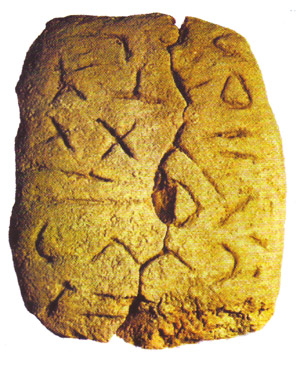
It is said that the neighbors began to
arrive the following day and not only found, but also took some of
the objects they found with them. Adrienne Picandet, a local
teacher, visited the Fradin's farm that same month and decided to
inform the Minister of Education. On July 9, Benoit Clément, another
teacher, this time from the neighboring village and representing the
Societé d'Emulation du Bourbonnais, visited the site and
later returned with a man called Viple.
Clément and Viple used pickaxes to break
down the remaining walls, which they took away with them. Some weeks
later, Émile Fradin received a letter from Viple identifying the
site as Gallo-Roman. He added that he felt it to be of little
interest and advised to recommence the cultivation of the field –
which is what the Fradin family did.
A not too ominous start therefore. The January 1925 issue of the
Bulletin de la Societé d'Emulation du Bourbonnais reported on
the findings, specifically focusing on a stone that carried
inscriptions. Despite having stated that the site was of little
interest, Clément requested 50 francs from the organization so that
more organized excavations could occur, but the bulletin reported
that this request had been denied.
The report brought the story to the attention of Antonin Morlet, a
Vichy physician and amateur archaeologist. Morlet visited Clément
and was intrigued by the findings. Morlet was an “amateur
specialist” in the Gallo-Roman period and believed that the objects
from Glozel were older. He believed that some might even date from
the Magdalenian period (12,000-9500 BC), as they involved bone
harpoons and depictions of reindeer, though to be extinct since
10,000 BC.
Both men visited the farm and the field on April 26, 1925, Morlet
offering the Fradins 200 francs per year to be allowed to complete
the excavation. He began his excavations on May 24, discovering
tablets, idols, bone and flint tools and engraved stones. He
published his “Nouvelle Station Néolithique” in September 1925,
listing Émile Fradin as co-author, arguing that the site was, as the
title of the report states, Neolithic in nature.
The book came to the attention of the
media and the first newspaper articles on the site featured in Le
Matin in October and in Le Mercure de France in December.
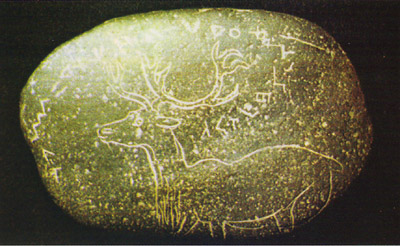
Though Morlet dated it as Neolithic, he
was not blind to see that the site contained objects from various
epochs. He still upheld his belief that some artifacts appeared to
be older, belonging to the Magdalenian period, but added that the
techniques that had been used appeared to be Neolithic. As such, he
identified Glozel as a transition site between both eras, even
though it was known that the two eras were separated by several
millennia.
Certain objects were indeed anachronistic: one stone showed a
reindeer, accompanied by letters that appeared to be an alphabet. As
mentioned, reindeer were believed to have vanished from the region
around 10,000 BC, yet the earliest known form of writing was then
established at 3300 BC, and that was in the Middle East. The general
consensus was that locally, one would have to wait a further three
millennia before the introduction of writing. Worse, the script
appeared to be comparable with the Phoenician alphabet, dated to ca.
1000 BC, or to the Iberian script, which was derived from it. But –
of course – it was “known” that no Phoenician colony could have been
located in Glozel.
No wonder therefore that French archaeological academia were
dismissive of Morlet's report; after all, it was published by an
amateur – a doctor – and a peasant boy – who could perhaps not even
write properly? The amateurism dripped off their conclusion, for it
challenged their carefully established and vociferously defended
dogma on several levels: prehistoric writing? A cross-over between a
Palaeolithic and Neolithic civilisation? Nonsense!
Unfortunately for French academic circles, Morlet was not one to lay
down easily and today, his ghost continues to watch – if not hang –
over Glozel. Morlet invited a number of archaeologists to visit the
site during 1926, including Salomon Reinach, curator of the National
Museum of Saint-Germain-en-Laye, who spent three days excavating.
Reinach confirmed the authenticity of the site in a communication to
the Academy of Inscriptions and Belles-Lettres. But even higher
academic circles descended on the site: the famous archaeologist
Abbé Breuil excavated with Morlet and was impressed with the site,
but on October 2 Breuil wrote that "everything is false except the
stoneware pottery" – doing a remarkable turn-around.
What had happened? Breuil worked
together with André Vayson de Pradenne and the latter argued that he
had found, in a popular magazine, images of prehistoric engravings
that were similar to those discovered by Fradin. This led him to
conclude that Fradin had created artefacts conform to the images in
the magazine.
Despite such allegations, Morlet unearthed thousands of objects over
a period of two years, all of varied forms and shape, including a
hundred tablets carrying signs and approximately fifteen tablets
carrying the imprints of human hands. Other discoveries were sexual
idols, polished stones, dressed stones, ceramics, glass, bones, etc.
How Fradin could possibly have made thousands of objects, the likes
of Vayson de Pradenne never explained…
Furthermore, two other tombs were uncovered in June 1927. One
contained 67, the other 121 objects and human remains. It seemed
that Glozel was soon to be accepted as a major archaeological
discovery. At the meeting of the International Institute of
Anthropology in Amsterdam, held in September 1927, Glozel was
therefore the subject of heated debate.
A commission was appointed to do further
investigations and arrived in Glozel on November 5, 1927.
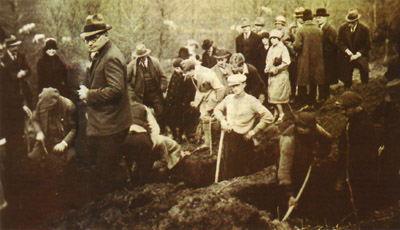
During their three day excavation, the
archaeologists uncovered various artifacts, but in their report of
December 1927, the commission declared everything, with the
exception of a few pieces of flint axes and stone ware, as fake. It
was then that the worst of all accusations was leveled against
Fradin and it came from the highest circle of academia: René Dussaud,
curator at the Louvre and a famous epigrapher, accused Émile Fradin
of forgery.
In a move that seems to have been a few
decades ahead of his time, on January 10, 1927, Fradin then filed
suit for defamation against Dussaud.
That move delineated the two camps: on the one hand, Fradin and
Morlet; on the other side, the academia, led by Dussaud… and any
academic who felt he had, should or better should stand next to this
juggernaut. No surprise therefore to see the president of the French
Prehistoric Society Felix Regnault visit Glozel on February 24, and
after the briefest of visits to the small museum, filing a complaint
against X –i.e. Fradin.
The accusation was that the cost of 4
francs of admission charges was excessive to see objects which in
his opinion were fake. The police searched the museum the next day,
destroyed glass display cases and confiscated three cases of
artifacts. On February 28, the suit against Dussaud was postponed
due to Regnault's pending indictment against Fradin – the criminal
case of fraud taking priority over the civil action suit.
A new group of neutral archaeologists, called the Committee of
Studies, was appointed by scholars who were uncomfortable with the
legal indictment slinging between the two camps as well as the
Commission that had been set up during the Amsterdam conference.
They excavated from 12 to 14 April 1928 and also found artifacts.
Their report spoke out for the authenticity of the site, which they
identified as Neolithic. It seemed that Morlet had been vindicated,
but the conclusion was soon shrunk in importance when Gaston-Edmond
Bayle, chief of the Criminal Records Office in Paris analyzed the
confiscated artifacts and in May 1929 identified them as recent
forgeries.
Bayle argued that he could detect fragments of what might have been
grass and an apple stem in some of the Glozellian clay tablets. As
grass obviously could not have withstood thousands of years, it was
a recent forgery. The argument is very unconvincing, for the
excavations were obviously not done as a forensic crime scene would
be treated. Most likely, the vast majority of these artifacts were
placed on grass or elsewhere after they were dug up from the pit – a
practice that continues on most of today’s archaeological
excavations; archaeology is, at this level, not a forensic science.
Furthermore, it is known that some of
the objects were actually heated in the oven of Fradin’s home, to
dry them. Bizarrely, a few months later, Bayle was assassinated in
an unrelated event; his assassin accused him of having made a
fraudulent report against him! Still, his subordinates continued his
work and they too were critical of the site, as was a report on the
artifacts produced by Champion, a technician at the Museé de St.
Germain-en-Laye.
As a consequence of Bayle’s report, on June 4, 1929, Émile Fradin
was indicted for fraud, but the judge eventually dismissed the case
in April 1931. This meant that the defamation charge against Dussaud
could and did come to trial in March 1932; Dussaud was found guilty
of defamation. Everyone will agree that all of this had very little
to do with archaeology and a lot to do with ego.
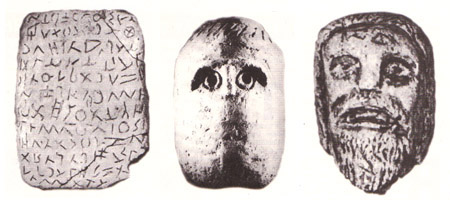
Morlet excavated the site from 1925 to
June 1938. During this decade of research, he discovered tables,
figurines, silex and bone utensils, engraved stones, etc. During the
1950s, Dr. Morlet made two attempts to have Glozel bones dated by
the new carbon-dating technique, once in France and once in the
United States. He died in 1965 without achieving the authentication
for which he had fought so hard.
The last time Fradin saw Morlet, the
doctor told him:
"You mustn't give up, you know. The
truth will come out before long."
So: fraud or genuine?
Perhaps the best
evidence that the site is genuine is Emile Fradin himself: a boy of
17 years of age, not very well educated, who would have spent
thousands of man-hours to create something he never sold? It seems
unlikely. Indeed, Fradin always refused to sell his objects.
Furthermore, all the experts in the field of prehistory initially
recognized the site as authentic; it were non-scientific
considerations that persuaded Capitan and to some extent Breuil to
switch sides: Morlet refused to name either as co-authors in his
report, whereas Vayson de Pradenne was upset because Fradin refused
to sell him his collection.
As to Dussaud, the man who rallied the
troops around him: he too had an ulterior motive, for in a recent
article, he had proposed that our alphabet was a Phoenician
invention. Morlet on the other hand argued that writing was known in
Europe millennia before. If Morlet and Glozel were right and
genuine, Dussaud’s theory would have been discredited. In
retrospect, neither his academic theories nor his character are
fondly remembered.
After 1942, a new law outlawed private excavations and the site
remained untouched until the Ministry of Culture re-opened
excavations in 1983. A full report was never published, but a 13
page summary appeared in 1995. This “official report” infuriated
many, for the authors suggested that the site was medieval, possibly
containing some Iron Age objects, but was likely enriched by
forgeries. It therefore reinforced the earlier position of the
leading French archaeologists. But on June 16, 1990, Emile Fradin
received the “Palmes Académiques”, suggesting that the French
academic circles had accepted him as making a legitimate discovery –
and that he was not a forger.
As late as 1990, Glozel thus continued to be controversial and not
at all straightforward. The official report states that glass found
at Glozel shows it is indeed from the medieval period. Furthermore,
in 1995, Alice and Sam Gerard, together with Robert Liris, dated two
bone tubes found in Tomb II to the 13th century. So there is a
medieval dimension to Glozel. If medieval, it would not be the
spectacular discovery that many have given it, but it would also
confirm that Fradin did not create the site. But that is not the
total “truth”.
Thermo-luminescence dating of 27
artifacts revealed three distinct periods: the first between 300 BC
and 300 AD (Celtic and Roman Gaul, as the earliest report on Glozel
had indicated), the second medieval (13th century), and the third,
rather remarkably, recent, suggesting these could potentially be
frauds mixed with genuine artifacts. And though carbon-dating of
bone fragments have ranged from the 13th to the 20th century, one
human femur was actually dated to the 5th century.
So, it seems, Morlet was wrong and Glozel was not a Neolithic site.
What was it then?
The central “Fosse Ovale” is now known to have
been a glass kiln which was then converted, in the 13th century,
into a tomb. Tomb I and II seem to have been Gallo-Roman tombs,
though a skull found in Tomb I was dated to the 19th century and
three human skulls from Tomb II to the 13-14th century. The “hard”
evidence therefore suggests that there is no Neolithic dimension to
the site and that it is at best Gallo-Roman, to which burials were
added in the 13th century.
Morlet had been convinced of its Neolithic origins because of the
artifacts uncovered at the site. The depiction of reindeer had
pushed it to 10,000 BC, though it is now known that reindeer
survived in isolated locations in Europe and may have been known as
late as Gallo-Roman if not medieval times. Whereas some have argued
the depictions of reindeer are actually red deer, qualified
zoologists (rather than archaeologists) have identified the
engravings as reindeer, not red deer as the archaeologists prefer to
label them.
By far the most captivating, and
controversial aspect of the site are the so-called “Glozel tablets”.
Some 100 ceramic tablets bearing inscriptions have been found. The
inscriptions are on average on six or seven lines, mostly on a
single side, although some specimens are inscribed on both faces. If
these had been Neolithic, Glozel would have been evidence that our
Neolithic ancestors had a script and would have caused a scientific
reappraisal of our forefather’s knowledge.
Are they?
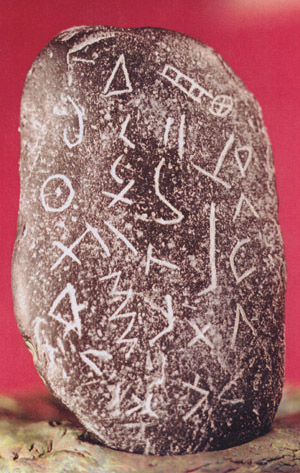
The tablet inscriptions are reminiscent
of the Phoenician alphabet and for some are precisely that. Over the
years, there have been numerous claims of decipherment, including
identification of the language of the inscriptions as Basque, Chaldean, Eteocretan, Hebrew, Iberian, Latin, Berber, Ligurian,
Turkic and the already mentioned Phoenician.
Amongst the various
attempts, one stands out: the suggestion from Hans-Rudolf Hitz, who
suggested a Celtic origin for the script and dated the inscriptions
to between the 3rd century BC and the 1st century AD – a timeframe
that would be acceptable by academics, as it sits within the three
periods identified via thermo-luminescence and carbon-dating, and
which conforms to Clément’s conclusion.
Hitz created an alphabet of 25 signs,
augmented by some sixty variations and ligatures and believed that
it was influenced by the Lepontic alphabet of Lugano, itself
descended from the Etruscan alphabet, reading some Lepontic proper
names like Setu (Lepontic Setu-pokios), Attec (Lepontic Ati, Atecua),
Uenit (Lepontic Uenia), Tepu (Lepontic Atepu). Hitz even claims
discovery of the toponym Glozel itself, as nemu chlausei "in the
sacred place of Glozel" (comparing nemu to Gaulish nemeton).
Still, Hitz also argues that there are
some inscriptions that do not make any sense whatsoever and these
nonsensical artifacts have been dated by other means to the 13th
century; it is believed that those who used the site as a cemetery
in the 13th century tried to copy some of the older artifacts found
on site, but as they were obviously unable to understand the script,
tried to imitate the signs seen on the stones and urns, ending up
with nonsense, but a nevertheless aesthetically pleasing offering
for their deceased.
Though Fradin continues to believe Morlet and the site’s Neolithic
nature, few now support it, seeing that the “hard dating” techniques
have provided far more recent dates. Furthermore, Glozel is not as
important as its notoriety has made it appear. It has been described
as the “Dreyfus Affair” of French archaeology. In early 1999, Guy
Lesec described Glozel as a Rorschach test.
Despite all of that, the possibility of a Neolithic dimension was
reopened in 1993, when a megalithic alignment made up out of 111
stones between the field and Glozel was discovered. The alignment
sits along an old road and leads up to the brow of the hill, where
there is a half circle with a large boulder in the centre. The
megalithic alignment was partially destroyed in the early 20th
century, but it is known to have been about 100 meters long and
roughly orientated north-south, in the direction of Field of Death.
This is evidence that Glozel as a whole had a Neolithic component.
Finally, Glozel is not as unique as many believe. After the initial
discovery had been made, Claude Fradin remembered that the Guillonet
family, the tenant farmers who lived there before them, had found a
vase with a mysterious inscription around it in the same field. In
January 1928, the Mercier family, who owned Chez Guerrier, the farm
next to Glozel, found a stone inscribed with 21 letters and a horse.
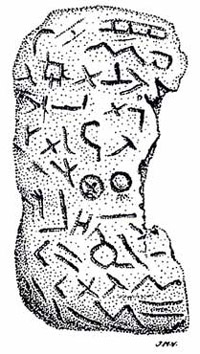
He got in touch with Morlet, who found
more artifacts on the site. Other sites in area added to the
treasure chest. The site of Puyravel, 2.5 km from Glozel, yielded 13
stone artifacts, some engraved with animals and letters. Artifacts
were also found at Palissard, 500 meters from Glozel, and Moulin-Piat,
2.5 km from the site. It suggests that the entire area was of some
importance to our forefathers, where vases and other materials were
either buried together with dead, or where these artifacts were
offered, perhaps because the area was sacred to a specific deity.
But the shadow of Glozel’s controversy
is so strong and controversial that the true history of the region
may never be illuminated… and our understanding of history is the
biggest victim in an affaire that should since long have progressed
from the fake-no fake debate.
Back to Contents
|







